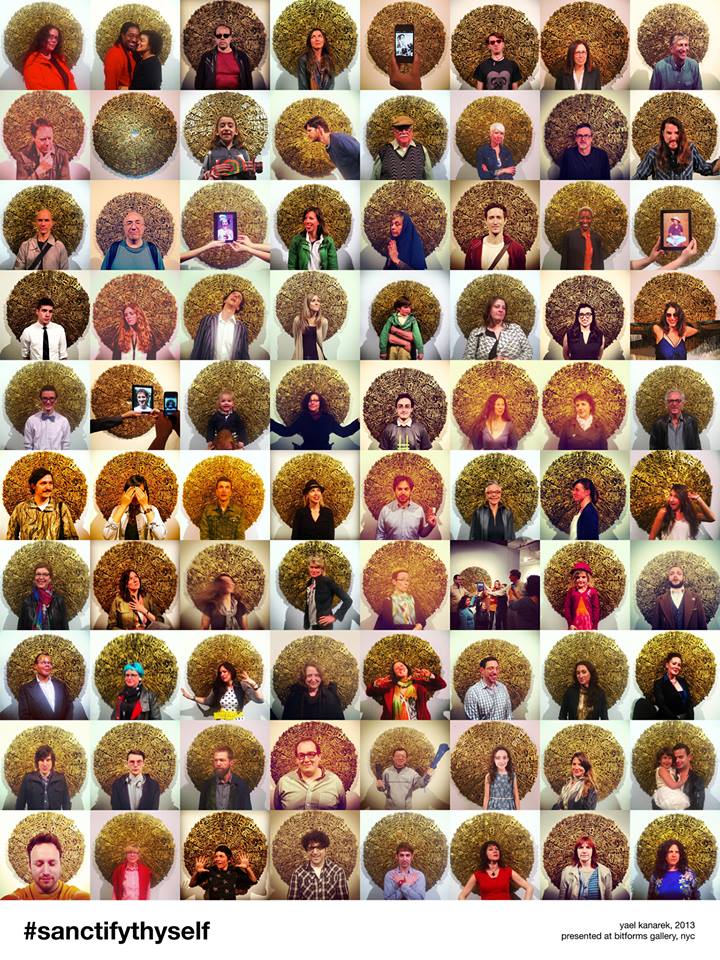
Digital printed poster
Edition of 450
signed, not numbered
#sanctifythyself Instagram feed
The poster was composed from a selection of over 250 Instagram photos taken during the solo exhibition "High Performance Gear" at bitforms gallery. The action invited visitors to the gallery and remote participants, to turn their back on the artwork Sanctify Thyself to create a halo around their heads.
The action was motivated by Jane Hirshfield's interview in David Grubin's The Buddha: The Story of Siddhartha. She discusses identifying the Buddha in ordinary life.
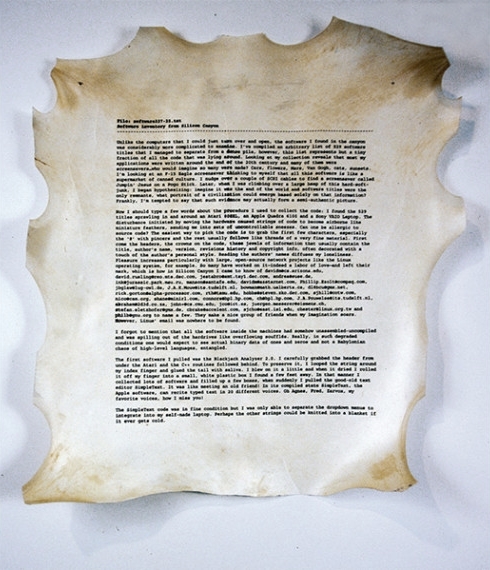
Silkscreen on parchment
Diary entry from World of Awe: A Traveler's Journal silk-screened on parchment
Font: Courier
Text:
File: software327-25.txt Software inventory from Silicon Canyon
--------------------------------------------------------------
Unlike the computers that I could just turn over and open, the software I found in the canyon was considerably more complicated to examine. I've compiled an arbitrary list of 529software titles that I managed to separate from a dense pile, however, this list represents but a tiny fraction of all the code that was lying around. Looking at my collection reveals that most of the applications were written around the end of the 20th century and many of them were screensavers … who would imagine so many were made?Cars, flowers, Mars,Van Gogh, cats, sunsets. I'm looking at an F-15 Eagle screensaver thinking to myself that all this software is like a supermarket of canned culture. I nudge over a couple of SCSI cables to find a screensaver called Jumpin' Jesus on a Pogo Stick.Later, when I was climbing over a large heap of this hard-soft-junk, I began hypothesizing: imagine it was the end of the world and software titles were the only remnants, what portrait of a civilization could emerge based solely on that information? Frankly, I'm tempted to say that such evidence may actually form a semi-authentic picture.
Now I should type a few words about the procedure I used to collect the code: I found the 529 titles sprawling in and around an Atari800XL, an Apple Quadra 6100 and a Sony VAIO Laptop.The disturbance initiated by moving the hardware caused strings of code to become airborne like miniature feathers, sending me into sets of uncontrollable sneezes. Can one be allergic to source code? The easiest way to pick the code is to grab the first few characters, especially the '#' with pincers and the rest usually follows like threads of a very fine material. First come the headers, the crowns on the code, these jewels of information that usually contain the title,author's name, version, revisions history and copyright info, often decorated with a touch of the author's personal style. Reading the authors' names diffuses my loneliness. Pleasure increases particularly with large, open-source network projects like the Linux operating system, for example. So many have worked on it—indeed a labor of love—and left their mark, which is how in Silicon Canyon I came to know of davidm@cs.arizona.edu, david.rusling@reo.mts.dec.com, jestabro@amt.tay1.dec.com, andrea@suse.de, ink@jurassic.park.msu.ru, manson@santafe.edu, davidm@azstarnet.com, Phillip.Ezolt@compaq.com, jbglaw@lug-owl.de, J.A.K.Mouw@its.tudelft.nl, bowman@math.ualberta.ca, dl8bcu@gmx.net, rick.gorton@alpha-processor.com, rth@tamu.edu, hobbs@steven.zko.dec.com, sjhill@cotw.com, nico@cam.org, shane@minirl.com, connors@hpl.hp.com, ch@hpl.hp.com, J.A.Pouwelse@its.tudelft.nl, abraham@2d3d.co.za, john+@cs.cmu.edu, jco@ict.es, juergen.messerer@siemens.ch, stefan.eletzhofer@gmx.de, cbrake@accelent.com, sjcho@east.isi.edu, chester@linux.org.tw andphilb@gnu.org to name a few. They make a nice group of friends when my imagination soars. However, Linus' email was nowhere to be found.
I forgot to mention that all the software inside the machines had some how unassembled-uncompiled and was spilling out of the hard drives like overflowing soufflés. Really, in such degraded conditions one would expect to see actual binary data of ones and zeros and not a Babylonian chaos of high-level languages, entangled.
The first software I pulled was the Blackjack Analyzer 2.0. I carefully grabbed the header from under the Atari and the C++ routines followed behind. To preserve it, I looped the string around my index finger and glued the tail with saliva. I blew on it a little and when it dried I rolled it off my finger into a small, white plastic box I found a few feet away. In that manner I collected lots of software and filled up a few boxes, when suddenly I pulled thegood-old text editorSimpleText. It was like meeting an old friend! Inits compiled stateSimpleText, the Apple software, can recite typed text in 20 different voices. Oh Agnes, Fred, Zarvox, my favorite voices, how I miss you!
The SimpleText code was in fine condition but I was only able to separate the dropdown menus to integrate into my selfmade laptop. Perhaps the other strings could be knitted into a blanket if it ever gets cold.
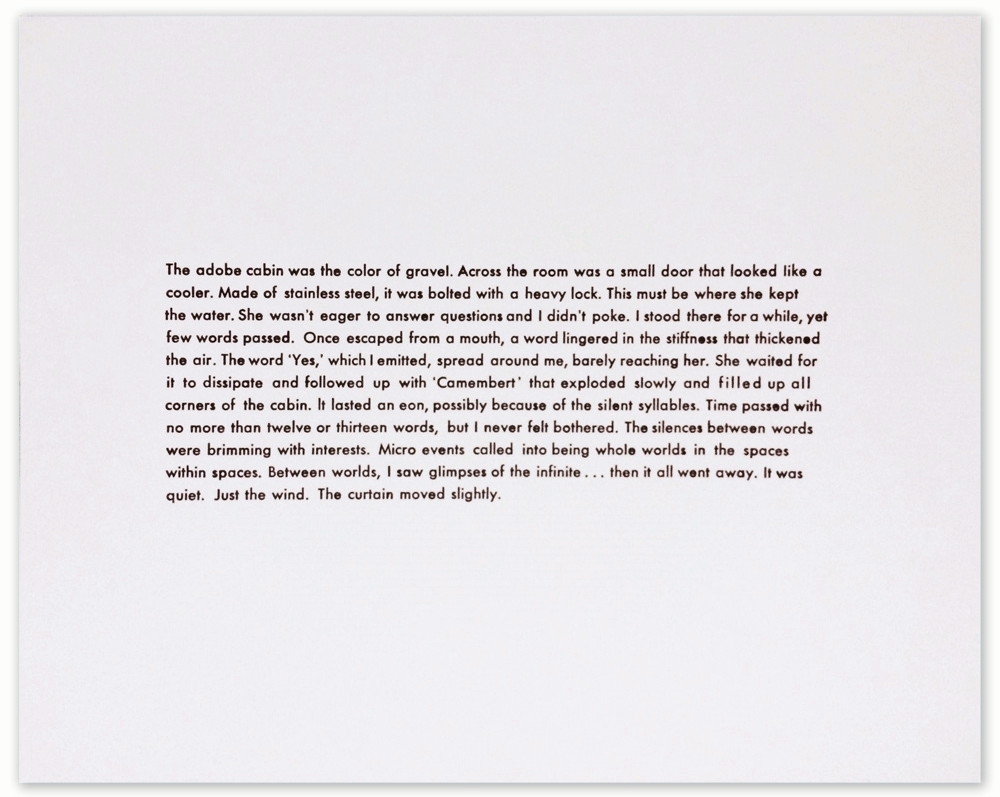
Handset letterpress print, purple ink on paper
11.25 x 14.25" / 28.6 x 36.2 cm
1/13 2AP
Letterpress prints of a paragraph from World of Awe: A Traveler's Journal, handset and printed during an artist's visit to the Goldsmith Press & Rare Type Collection at Austin Peay State University.
Text:
Travelog 159-78: Oldy, paragraph 7
The adobe cabin was the color of gravel. Across the room was a small door that looked like a cooler. Made of stainless steel, it was bolted with a heavy lock. This must be where she kept the water. She wasn’t eager to answer questions and I didn’t poke. I stood there for a while, yet few words passed. Once escaped from a mouth, a word lingered in the stiffness that thickened the air. The word 'Yes,' which I emitted, spread around me, barely reaching her. She waited for it to dissipate and followed up with 'Camembert' that exploded slowly and filled up all corners of the cabin. It lasted an eon, possibly because of the silent syllables. Time passed with no more then twelve or thirteen words, but I never felt bothered. The silences between words were brimming with interests. Micro events called into being whole worlds in the spaces within spaces. Between worlds, I saw glimpses of the infinite... then it all went away. It was quiet. Just the wind. The curtain moved slightly.
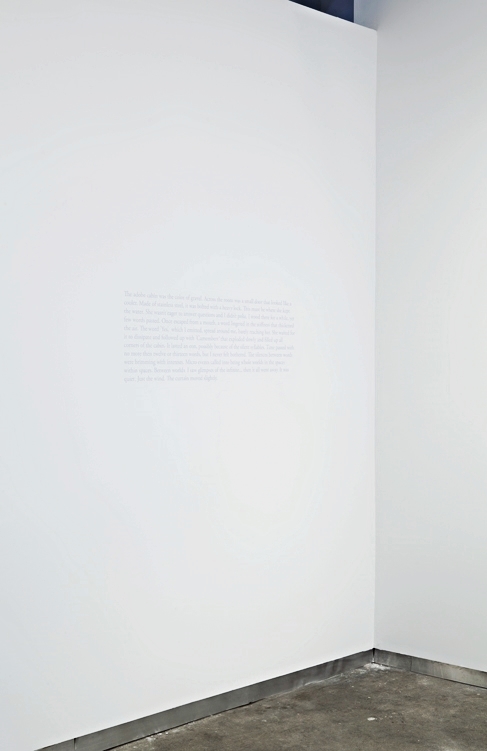
Vinyl wall text
Dimensions variable

Lambda print
44.5 x 70" / 113 x 178 cm
Edition of 3
This landscape is animated in the scene Copy, from Object of Desire:
Travelog 720.5/2: Copy
Sunset/Sunrise
Tangerine sky. A ray illuminates my neck. It stays there. Time suspended. I key my notes into the laptop. Letters dispel the handwriting and elude my temper, paper, and the ballpoint pen.
The laptop welcomes the letters and assigns them numbers. Electric-alive, my idiom flickers on the screen. Delighted in the power of computation: Copy, paste, find, replace. CTRL+Z. Power. Speed. I penetrate.
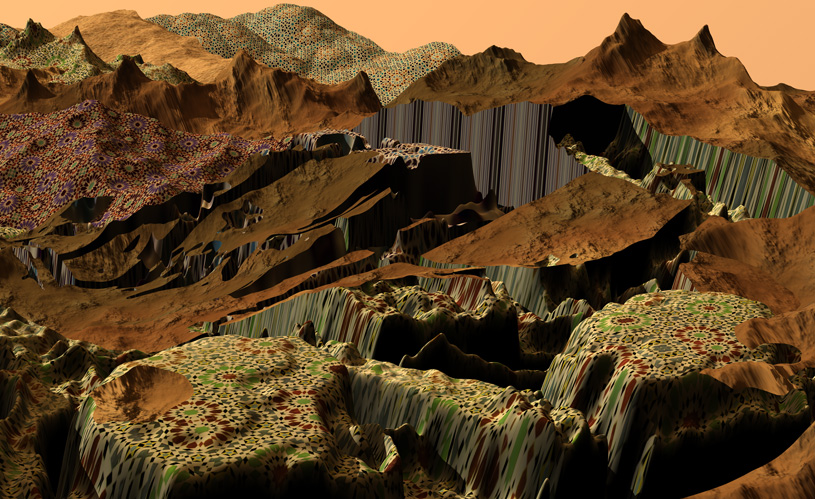
Lambda print
44.5 x 70 in / 113 x 178 cm
Edition of 3
This landscape is "torn" by mapping a journalistic photo of a political murder that circulated in the news several years ago. Its source is the Israeli-Palestinian conflict.

Ink drawing on Lambda print plexi-mounted
44 x 34 in / 112 x 86 cm
Unique
About traffic data: As visitors navigate the net artwork World of Awe: A Traveler's Journal they leave tracking data like footprints. That data includes IP address, pages visited and time of entry. The data is then filtered and hand-drawn, spontaneously, on the 3D desert landscape print.
Here the traffic data was filtered to identify the first and last diary entry accessed by several visitors. The difference in timestamps indicate the time they spent in the Traveler's Journal.

Ink drawing on Lambda print
30 x 40 in / 76 x 102 cm
Unique
As visitors navigate World of Awe: A Traveler's Journal, they leave behind tracking data including IP address, pages visited, and time of download requests. These traces are then filtered and spontaneously hand-drawn on the 3D desert landscape print.
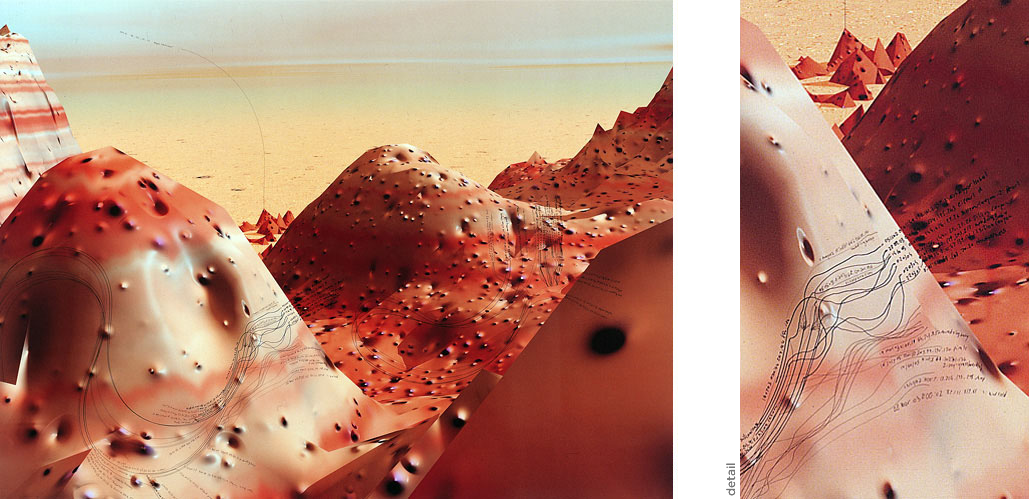
Ink drawing on Lambda print
30 x 40 in / 76 x 102 cm
Unique
As visitors navigate World of Awe: A Traveler's Journal, they leave behind tracking data including IP address, pages visited, and time of download requests. These traces are then filtered and spontaneously hand-drawn on the 3D desert landscape print.
The data in this piece represents the first 90 seconds of the day: 00:00:00 – 00:01:30.

Ink drawing on Lambda print
30 x 40 in / 76 x 102 cm
Unique
As visitors navigate World of Awe: A Traveler's Journal, they leave behind tracking data including IP address, pages visited, and time of download requests. These traces are then filtered and spontaneously hand-drawn on the 3D desert landscape print.
This data represents a swarm of timestamps that hit the server over a period of several months.
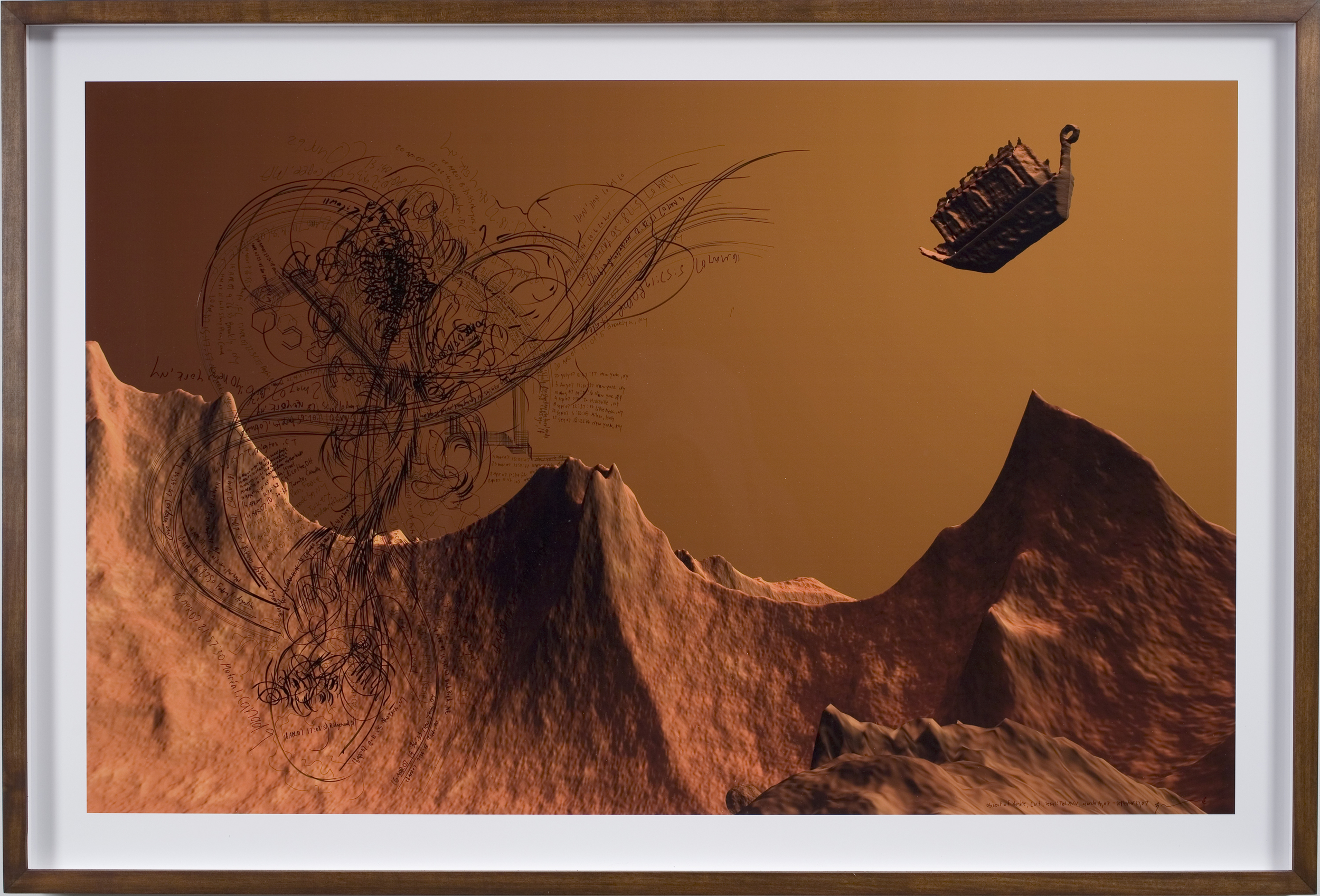
Ink drawing on Lambda print
29 x 42.5 in / 74 x 108 cm
Unique
A rendering from the scene Undo in Object of Desire, using an image from the 1895 Montgomery Ward & Co. Catalogue and Buyer's Guide as the basis for the ark model. The hand-drawing interprets traffic data left by those who visited the Undo webpages, then hosted on a server in Tel Aviv by the Israeli Center for Digital Art's ArtLab.
This work was included in the solo exhibition Object of Desire exhibition at the Jewish Museum's Media Center in New York.

Ink drawing on Lambda print
20 x 15 in / 51 x 38 cm
Unique
Private collection
A rendering from the scene Crumbs in Object of Desire. The ink drawing interprets traffic data left by those who visited the Crumbs webpages, then hosted on a server in Ramallah, Palestine.

Digital C-Print
23 x 30 1/2 in / 58.6 x 77.2 cm
60 3/4 x 66 in / 154.2 x 167.6 cm
Edition of 6, 1 AP
"Cycles" is a photographic series of performed actions, as written in computer code (Linux Kernel). This machine language, a narrative of instructions based on English, is then transferred to organza ribbon. A single character, the User, performs machine and human functions in a sterile, functional environment warmed by low orange light reminiscent of a sunset or sunrise.
The final resting point for the code is in two sculptures: SPIN_LOCK and Heart in Heart.
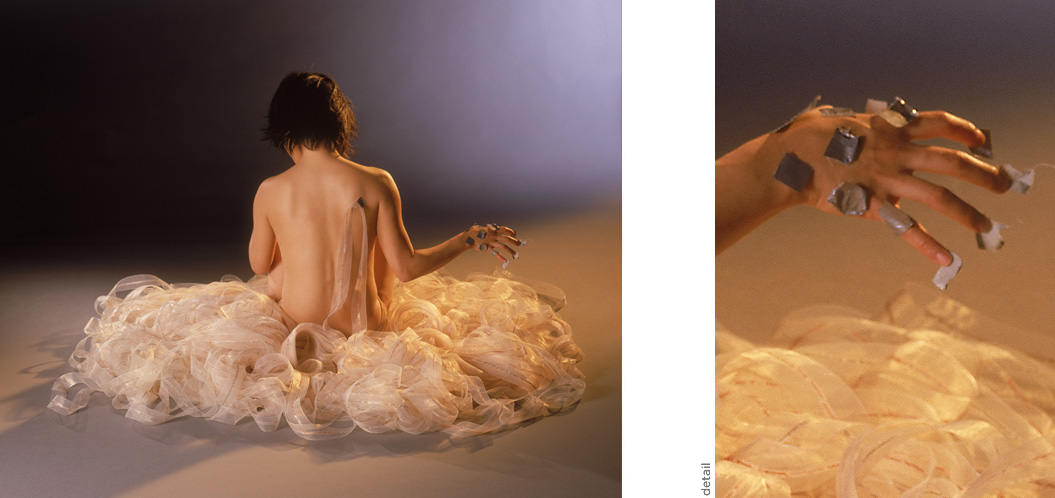
Digital C-Print
23 x 30 1/2 in / 58.6 x 77.2 cm
60 3/4 x 66 in / 154.2 x 167.6 cm
Edition of 6, 1 AP
"Cycles" is a photographic series of performed actions, as written in computer code (Linux Kernel). This machine language, a narrative of instructions based on English, is then transferred to organza ribbon. A single character, the User, performs machine and human functions in a sterile, functional environment warmed by low orange light reminiscent of a sunset or sunrise.
The final resting point for the code is in two sculptures: SPIN_LOCK and Heart in Heart.
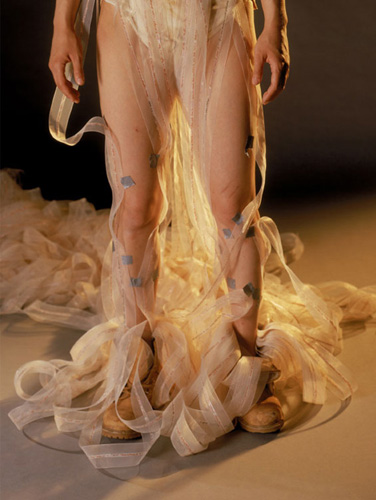
Digital C-Print
24 5/8 x 18 1/2 in / 62.5 x 47 cm
66 x 51 in / 167.6 x 129.5 cm
Edition of 6, 1 AP
"Cycles" is a photographic series of performed actions, as written in computer code (Linux Kernel). This machine language, a narrative of instructions based on English, is then transferred to organza ribbon. A single character, the User, performs machine and human functions in a sterile, functional environment warmed by low orange light reminiscent of a sunset or sunrise.
The final resting point for the code is in two sculptures: SPIN_LOCK and Heart in Heart.
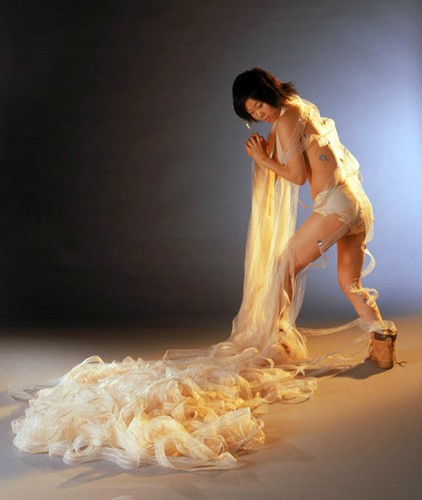
Digital C-print
28 x 21.5 in / 71.1 x 54.6 cm
66 x 51.75 in / 167.6 x 131.4 cm
Edition of 6, 1 AP
"Cycles" is a photographic series of performed actions, as written in computer code (Linux Kernel). This machine language, a narrative of instructions based on English, is then transferred to organza ribbon. A single character, the User, performs machine and human functions in a sterile, functional environment warmed by low orange light reminiscent of a sunset or sunrise.
The final resting point for the code is in two sculptures: SPIN_LOCK and Heart in Heart.

Digital C-Print
28 x 21 1/2 / 71.1 x 54.6 cm
66 x 51 3/4 / 167.6 x 131.4 cm
Edition of 6, 1 AP
"Cycles" is a photographic series of performed actions, as written in computer code (Linux Kernel). This machine language, a narrative of instructions based on English, is then transferred to organza ribbon. A single character, the User, performs machine and human functions in a sterile, functional environment warmed by low orange light reminiscent of a sunset or sunrise.
The final resting point for the code is in two sculptures: SPIN_LOCK and Heart in Heart.
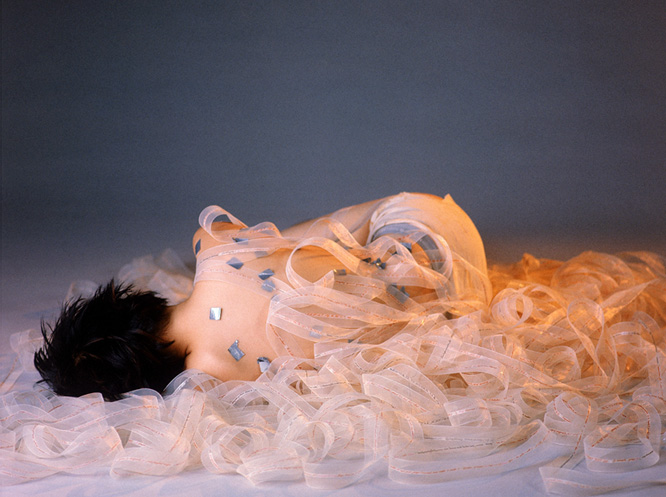
Digital C-print
13.5 x 18.5 in / 34 x 46.7 cm
44 x 34 in / 112 x 86 cm
Edition of 6, 1 AP
"Cycles" is a photographic series of performed actions, as written in computer code (Linux Kernel). This machine language, a narrative of instructions based on English, is then transferred to organza ribbon. A single character, the User, performs machine and human functions in a sterile, functional environment warmed by low orange light reminiscent of a sunset or sunrise.
The final resting point for the code is in two sculptures: SPIN_LOCK and Heart in Heart.
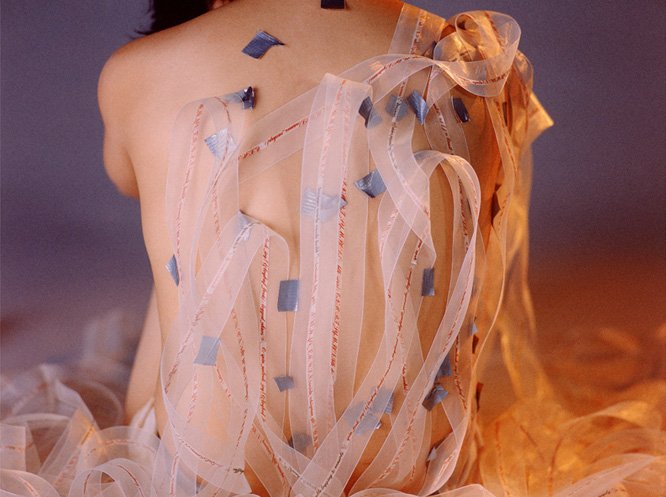
Digital C-Print
44 x 34 in / 112 x 86 cm
Edition of 6, 1 AP
"Cycles" is a photographic series of performed actions, as written in computer code (Linux Kernel). This machine language, a narrative of instructions based on English, is then transferred to organza ribbon. A single character, the User, performs machine and human functions in a sterile, functional environment warmed by low orange light reminiscent of a sunset or sunrise.
The final resting point for the code is in two sculptures: SPIN_LOCK and Heart in Heart.
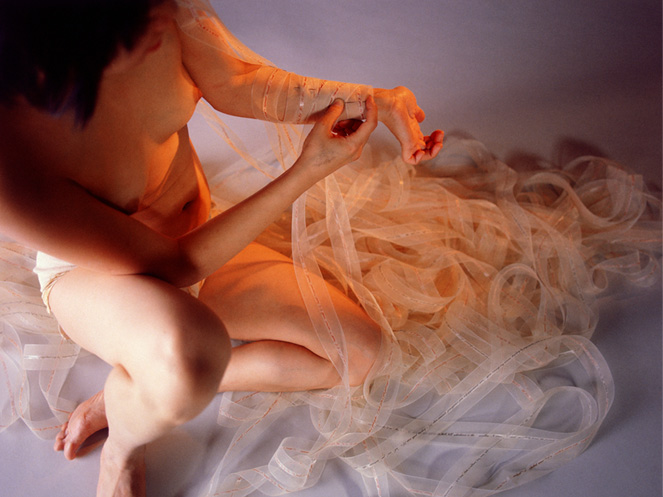
Digital C-Print
44 x 34 in / 112 x 86 cm
Edition of 6, 1 AP
"Cycles" is a photographic series of performed actions, as written in computer code (Linux Kernel). This machine language, a narrative of instructions based on English, is then transferred to organza ribbon. A single character, the User, performs machine and human functions in a sterile, functional environment warmed by low orange light reminiscent of a sunset or sunrise.
The final resting point for the code is in two sculptures: SPIN_LOCK and Heart in Heart.
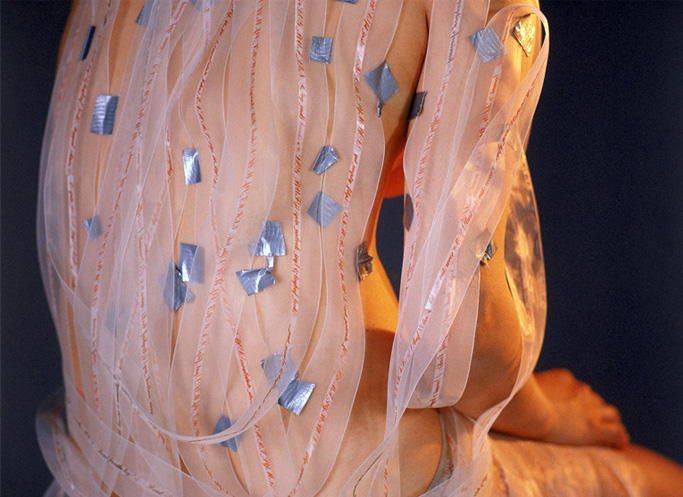
Digital C-print
13.5 x 18.5 in / 34 x 46.7 cm
44 x 34 in / 112 x 86 cm
Edition of 6, 1 AP
"Cycles" is a photographic series of performed actions, as written in computer code (Linux Kernel). This machine language, a narrative of instructions based on English, is then transferred to organza ribbon. A single character, the User, performs machine and human functions in a sterile, functional environment warmed by low orange light reminiscent of a sunset or sunrise.
The final resting point for the code is in two sculptures: SPIN_LOCK and Heart in Heart.
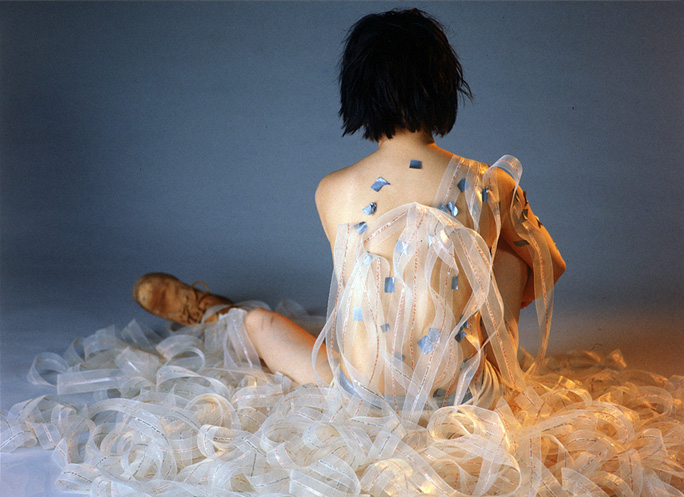
Digital C-print
13.5 x 18.5 in / 34 x 46.7 cm
44 x 34 in / 112 x 86 cm
Edition of 6, 1 AP
"Cycles" is a photographic series of performed actions, as written in computer code (Linux Kernel). This machine language, a narrative of instructions based on English, is then transferred to organza ribbon. A single character, the User, performs machine and human functions in a sterile, functional environment warmed by low orange light reminiscent of a sunset or sunrise.
The final resting point for the code is in two sculptures: SPIN_LOCK and Heart in Heart.
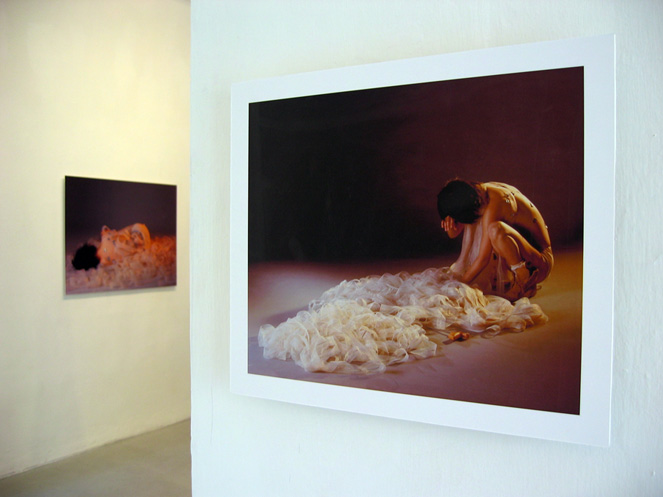
From Code:Skin at Nelly Aman Gallery, Tel Aviv.
"Cycles" is a photographic series of performed actions, as written in computer code (Linux Kernel). This machine language, a narrative of instructions based on English, is then transferred to organza ribbon. A single character, the User, performs machine and human functions in a sterile, functional environment warmed by low orange light reminiscent of a sunset or sunrise.
The final resting point for the code is in two sculptures: SPIN_LOCK and Heart in Heart.

The first flier in the East Village cafes to include a URL to a net art work, possibly the first flier to include a URL altogether.

Polaroid
Unique
This polaroid was taken on the corner of 7th Street and Avenue A. The establishment across the street is long gone. The polaroid was scanned and introduced into the net art piece it promotes to create a feedback loop between the physical and virtual spaces.

Cardboard box, black velvet, small things
These two polaroids show interior and exterior shots of the sculpture The Hole of the Lost Treasure.


























Digital printed poster
Edition of 450
signed, not numbered
#sanctifythyself Instagram feed
The poster was composed from a selection of over 250 Instagram photos taken during the solo exhibition "High Performance Gear" at bitforms gallery. The action invited visitors to the gallery and remote participants, to turn their back on the artwork Sanctify Thyself to create a halo around their heads.
The action was motivated by Jane Hirshfield's interview in David Grubin's The Buddha: The Story of Siddhartha. She discusses identifying the Buddha in ordinary life.
Silkscreen on parchment
Diary entry from World of Awe: A Traveler's Journal silk-screened on parchment
Font: Courier
Text:
File: software327-25.txt Software inventory from Silicon Canyon
--------------------------------------------------------------
Unlike the computers that I could just turn over and open, the software I found in the canyon was considerably more complicated to examine. I've compiled an arbitrary list of 529software titles that I managed to separate from a dense pile, however, this list represents but a tiny fraction of all the code that was lying around. Looking at my collection reveals that most of the applications were written around the end of the 20th century and many of them were screensavers … who would imagine so many were made?Cars, flowers, Mars,Van Gogh, cats, sunsets. I'm looking at an F-15 Eagle screensaver thinking to myself that all this software is like a supermarket of canned culture. I nudge over a couple of SCSI cables to find a screensaver called Jumpin' Jesus on a Pogo Stick.Later, when I was climbing over a large heap of this hard-soft-junk, I began hypothesizing: imagine it was the end of the world and software titles were the only remnants, what portrait of a civilization could emerge based solely on that information? Frankly, I'm tempted to say that such evidence may actually form a semi-authentic picture.
Now I should type a few words about the procedure I used to collect the code: I found the 529 titles sprawling in and around an Atari800XL, an Apple Quadra 6100 and a Sony VAIO Laptop.The disturbance initiated by moving the hardware caused strings of code to become airborne like miniature feathers, sending me into sets of uncontrollable sneezes. Can one be allergic to source code? The easiest way to pick the code is to grab the first few characters, especially the '#' with pincers and the rest usually follows like threads of a very fine material. First come the headers, the crowns on the code, these jewels of information that usually contain the title,author's name, version, revisions history and copyright info, often decorated with a touch of the author's personal style. Reading the authors' names diffuses my loneliness. Pleasure increases particularly with large, open-source network projects like the Linux operating system, for example. So many have worked on it—indeed a labor of love—and left their mark, which is how in Silicon Canyon I came to know of davidm@cs.arizona.edu, david.rusling@reo.mts.dec.com, jestabro@amt.tay1.dec.com, andrea@suse.de, ink@jurassic.park.msu.ru, manson@santafe.edu, davidm@azstarnet.com, Phillip.Ezolt@compaq.com, jbglaw@lug-owl.de, J.A.K.Mouw@its.tudelft.nl, bowman@math.ualberta.ca, dl8bcu@gmx.net, rick.gorton@alpha-processor.com, rth@tamu.edu, hobbs@steven.zko.dec.com, sjhill@cotw.com, nico@cam.org, shane@minirl.com, connors@hpl.hp.com, ch@hpl.hp.com, J.A.Pouwelse@its.tudelft.nl, abraham@2d3d.co.za, john+@cs.cmu.edu, jco@ict.es, juergen.messerer@siemens.ch, stefan.eletzhofer@gmx.de, cbrake@accelent.com, sjcho@east.isi.edu, chester@linux.org.tw andphilb@gnu.org to name a few. They make a nice group of friends when my imagination soars. However, Linus' email was nowhere to be found.
I forgot to mention that all the software inside the machines had some how unassembled-uncompiled and was spilling out of the hard drives like overflowing soufflés. Really, in such degraded conditions one would expect to see actual binary data of ones and zeros and not a Babylonian chaos of high-level languages, entangled.
The first software I pulled was the Blackjack Analyzer 2.0. I carefully grabbed the header from under the Atari and the C++ routines followed behind. To preserve it, I looped the string around my index finger and glued the tail with saliva. I blew on it a little and when it dried I rolled it off my finger into a small, white plastic box I found a few feet away. In that manner I collected lots of software and filled up a few boxes, when suddenly I pulled thegood-old text editorSimpleText. It was like meeting an old friend! Inits compiled stateSimpleText, the Apple software, can recite typed text in 20 different voices. Oh Agnes, Fred, Zarvox, my favorite voices, how I miss you!
The SimpleText code was in fine condition but I was only able to separate the dropdown menus to integrate into my selfmade laptop. Perhaps the other strings could be knitted into a blanket if it ever gets cold.
Handset letterpress print, purple ink on paper
11.25 x 14.25" / 28.6 x 36.2 cm
1/13 2AP
Letterpress prints of a paragraph from World of Awe: A Traveler's Journal, handset and printed during an artist's visit to the Goldsmith Press & Rare Type Collection at Austin Peay State University.
Text:
Travelog 159-78: Oldy, paragraph 7
The adobe cabin was the color of gravel. Across the room was a small door that looked like a cooler. Made of stainless steel, it was bolted with a heavy lock. This must be where she kept the water. She wasn’t eager to answer questions and I didn’t poke. I stood there for a while, yet few words passed. Once escaped from a mouth, a word lingered in the stiffness that thickened the air. The word 'Yes,' which I emitted, spread around me, barely reaching her. She waited for it to dissipate and followed up with 'Camembert' that exploded slowly and filled up all corners of the cabin. It lasted an eon, possibly because of the silent syllables. Time passed with no more then twelve or thirteen words, but I never felt bothered. The silences between words were brimming with interests. Micro events called into being whole worlds in the spaces within spaces. Between worlds, I saw glimpses of the infinite... then it all went away. It was quiet. Just the wind. The curtain moved slightly.
Vinyl wall text
Dimensions variable
Lambda print
44.5 x 70" / 113 x 178 cm
Edition of 3
This landscape is animated in the scene Copy, from Object of Desire:
Travelog 720.5/2: Copy
Sunset/Sunrise
Tangerine sky. A ray illuminates my neck. It stays there. Time suspended. I key my notes into the laptop. Letters dispel the handwriting and elude my temper, paper, and the ballpoint pen.
The laptop welcomes the letters and assigns them numbers. Electric-alive, my idiom flickers on the screen. Delighted in the power of computation: Copy, paste, find, replace. CTRL+Z. Power. Speed. I penetrate.
Lambda print
44.5 x 70 in / 113 x 178 cm
Edition of 3
This landscape is "torn" by mapping a journalistic photo of a political murder that circulated in the news several years ago. Its source is the Israeli-Palestinian conflict.
Ink drawing on Lambda print plexi-mounted
44 x 34 in / 112 x 86 cm
Unique
About traffic data: As visitors navigate the net artwork World of Awe: A Traveler's Journal they leave tracking data like footprints. That data includes IP address, pages visited and time of entry. The data is then filtered and hand-drawn, spontaneously, on the 3D desert landscape print.
Here the traffic data was filtered to identify the first and last diary entry accessed by several visitors. The difference in timestamps indicate the time they spent in the Traveler's Journal.
Ink drawing on Lambda print
30 x 40 in / 76 x 102 cm
Unique
As visitors navigate World of Awe: A Traveler's Journal, they leave behind tracking data including IP address, pages visited, and time of download requests. These traces are then filtered and spontaneously hand-drawn on the 3D desert landscape print.
Ink drawing on Lambda print
30 x 40 in / 76 x 102 cm
Unique
As visitors navigate World of Awe: A Traveler's Journal, they leave behind tracking data including IP address, pages visited, and time of download requests. These traces are then filtered and spontaneously hand-drawn on the 3D desert landscape print.
The data in this piece represents the first 90 seconds of the day: 00:00:00 – 00:01:30.
Ink drawing on Lambda print
30 x 40 in / 76 x 102 cm
Unique
As visitors navigate World of Awe: A Traveler's Journal, they leave behind tracking data including IP address, pages visited, and time of download requests. These traces are then filtered and spontaneously hand-drawn on the 3D desert landscape print.
This data represents a swarm of timestamps that hit the server over a period of several months.
Ink drawing on Lambda print
29 x 42.5 in / 74 x 108 cm
Unique
A rendering from the scene Undo in Object of Desire, using an image from the 1895 Montgomery Ward & Co. Catalogue and Buyer's Guide as the basis for the ark model. The hand-drawing interprets traffic data left by those who visited the Undo webpages, then hosted on a server in Tel Aviv by the Israeli Center for Digital Art's ArtLab.
This work was included in the solo exhibition Object of Desire exhibition at the Jewish Museum's Media Center in New York.
Ink drawing on Lambda print
20 x 15 in / 51 x 38 cm
Unique
Private collection
A rendering from the scene Crumbs in Object of Desire. The ink drawing interprets traffic data left by those who visited the Crumbs webpages, then hosted on a server in Ramallah, Palestine.
Digital C-Print
23 x 30 1/2 in / 58.6 x 77.2 cm
60 3/4 x 66 in / 154.2 x 167.6 cm
Edition of 6, 1 AP
"Cycles" is a photographic series of performed actions, as written in computer code (Linux Kernel). This machine language, a narrative of instructions based on English, is then transferred to organza ribbon. A single character, the User, performs machine and human functions in a sterile, functional environment warmed by low orange light reminiscent of a sunset or sunrise.
The final resting point for the code is in two sculptures: SPIN_LOCK and Heart in Heart.
Digital C-Print
23 x 30 1/2 in / 58.6 x 77.2 cm
60 3/4 x 66 in / 154.2 x 167.6 cm
Edition of 6, 1 AP
"Cycles" is a photographic series of performed actions, as written in computer code (Linux Kernel). This machine language, a narrative of instructions based on English, is then transferred to organza ribbon. A single character, the User, performs machine and human functions in a sterile, functional environment warmed by low orange light reminiscent of a sunset or sunrise.
The final resting point for the code is in two sculptures: SPIN_LOCK and Heart in Heart.
Digital C-Print
24 5/8 x 18 1/2 in / 62.5 x 47 cm
66 x 51 in / 167.6 x 129.5 cm
Edition of 6, 1 AP
"Cycles" is a photographic series of performed actions, as written in computer code (Linux Kernel). This machine language, a narrative of instructions based on English, is then transferred to organza ribbon. A single character, the User, performs machine and human functions in a sterile, functional environment warmed by low orange light reminiscent of a sunset or sunrise.
The final resting point for the code is in two sculptures: SPIN_LOCK and Heart in Heart.
Digital C-print
28 x 21.5 in / 71.1 x 54.6 cm
66 x 51.75 in / 167.6 x 131.4 cm
Edition of 6, 1 AP
"Cycles" is a photographic series of performed actions, as written in computer code (Linux Kernel). This machine language, a narrative of instructions based on English, is then transferred to organza ribbon. A single character, the User, performs machine and human functions in a sterile, functional environment warmed by low orange light reminiscent of a sunset or sunrise.
The final resting point for the code is in two sculptures: SPIN_LOCK and Heart in Heart.
Digital C-Print
28 x 21 1/2 / 71.1 x 54.6 cm
66 x 51 3/4 / 167.6 x 131.4 cm
Edition of 6, 1 AP
"Cycles" is a photographic series of performed actions, as written in computer code (Linux Kernel). This machine language, a narrative of instructions based on English, is then transferred to organza ribbon. A single character, the User, performs machine and human functions in a sterile, functional environment warmed by low orange light reminiscent of a sunset or sunrise.
The final resting point for the code is in two sculptures: SPIN_LOCK and Heart in Heart.
Digital C-print
13.5 x 18.5 in / 34 x 46.7 cm
44 x 34 in / 112 x 86 cm
Edition of 6, 1 AP
"Cycles" is a photographic series of performed actions, as written in computer code (Linux Kernel). This machine language, a narrative of instructions based on English, is then transferred to organza ribbon. A single character, the User, performs machine and human functions in a sterile, functional environment warmed by low orange light reminiscent of a sunset or sunrise.
The final resting point for the code is in two sculptures: SPIN_LOCK and Heart in Heart.
Digital C-Print
44 x 34 in / 112 x 86 cm
Edition of 6, 1 AP
"Cycles" is a photographic series of performed actions, as written in computer code (Linux Kernel). This machine language, a narrative of instructions based on English, is then transferred to organza ribbon. A single character, the User, performs machine and human functions in a sterile, functional environment warmed by low orange light reminiscent of a sunset or sunrise.
The final resting point for the code is in two sculptures: SPIN_LOCK and Heart in Heart.
Digital C-Print
44 x 34 in / 112 x 86 cm
Edition of 6, 1 AP
"Cycles" is a photographic series of performed actions, as written in computer code (Linux Kernel). This machine language, a narrative of instructions based on English, is then transferred to organza ribbon. A single character, the User, performs machine and human functions in a sterile, functional environment warmed by low orange light reminiscent of a sunset or sunrise.
The final resting point for the code is in two sculptures: SPIN_LOCK and Heart in Heart.
Digital C-print
13.5 x 18.5 in / 34 x 46.7 cm
44 x 34 in / 112 x 86 cm
Edition of 6, 1 AP
"Cycles" is a photographic series of performed actions, as written in computer code (Linux Kernel). This machine language, a narrative of instructions based on English, is then transferred to organza ribbon. A single character, the User, performs machine and human functions in a sterile, functional environment warmed by low orange light reminiscent of a sunset or sunrise.
The final resting point for the code is in two sculptures: SPIN_LOCK and Heart in Heart.
Digital C-print
13.5 x 18.5 in / 34 x 46.7 cm
44 x 34 in / 112 x 86 cm
Edition of 6, 1 AP
"Cycles" is a photographic series of performed actions, as written in computer code (Linux Kernel). This machine language, a narrative of instructions based on English, is then transferred to organza ribbon. A single character, the User, performs machine and human functions in a sterile, functional environment warmed by low orange light reminiscent of a sunset or sunrise.
The final resting point for the code is in two sculptures: SPIN_LOCK and Heart in Heart.
From Code:Skin at Nelly Aman Gallery, Tel Aviv.
"Cycles" is a photographic series of performed actions, as written in computer code (Linux Kernel). This machine language, a narrative of instructions based on English, is then transferred to organza ribbon. A single character, the User, performs machine and human functions in a sterile, functional environment warmed by low orange light reminiscent of a sunset or sunrise.
The final resting point for the code is in two sculptures: SPIN_LOCK and Heart in Heart.
The first flier in the East Village cafes to include a URL to a net art work, possibly the first flier to include a URL altogether.
Polaroid
Unique
This polaroid was taken on the corner of 7th Street and Avenue A. The establishment across the street is long gone. The polaroid was scanned and introduced into the net art piece it promotes to create a feedback loop between the physical and virtual spaces.
Cardboard box, black velvet, small things
These two polaroids show interior and exterior shots of the sculpture The Hole of the Lost Treasure.